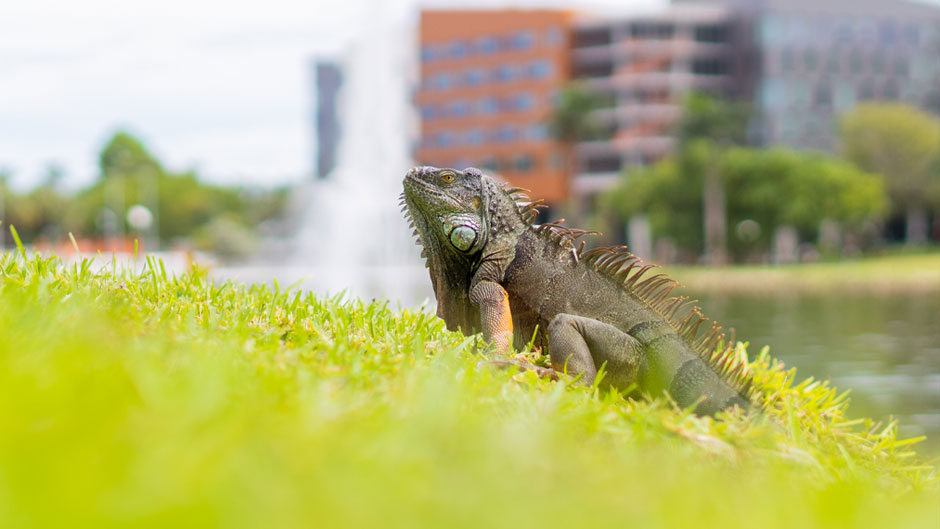With a cold front from Canada set to sweep into the region Saturday, many in South Florida are wondering—will it be raining iguanas this weekend?
There’s a strong possibility, said Christopher Searcy, a University of Miami assistant professor of biology.
“If you get an extended period of time where it’s below 45 degrees, there will likely be falling lizards,” he said.
 Searcy, a herpetologist, or expert in the study of reptiles and amphibians, worked with a graduate student in 2020 on a research study about the cold tolerance of lizards. They learned that when temperatures dip below 45 degrees Fahrenheit, it causes lizards and iguanas to undergo a temporary cold shock until they can get their body heat back up again. Through the research, they also learned that the lizards and iguanas that did not die during a cold snap in 2020, are likely those that are the most cold-tolerant. Therefore, Searcy predicts the lizards of today may be better adapted to Miami winters.
Searcy, a herpetologist, or expert in the study of reptiles and amphibians, worked with a graduate student in 2020 on a research study about the cold tolerance of lizards. They learned that when temperatures dip below 45 degrees Fahrenheit, it causes lizards and iguanas to undergo a temporary cold shock until they can get their body heat back up again. Through the research, they also learned that the lizards and iguanas that did not die during a cold snap in 2020, are likely those that are the most cold-tolerant. Therefore, Searcy predicts the lizards of today may be better adapted to Miami winters.
Searcy answered a few questions to explain why chilly temperatures are so debilitating for reptiles.
Why do lizards and iguanas fall out of trees when it’s cold?
Arboreal lizards sleep at the end of tree branches because it is harder for predators to reach them there (at least without the lizard noticing the branch shaking). However, when it gets below 45 degrees, lizards get so cold that they lose the ability to move their limbs. Then, if the tree branch moves, they fall to the ground. While the fall may cause the lizard to die, they are usually not dead when they fall. And unless it gets below freezing, they aren’t frozen either.
What happens to lizards and iguanas’ bodies when temperatures decline?
Reptiles are ectotherms, which means they are dependent on external sources of heat. This is very different from humans (and all mammals), which are endotherms, and use our own metabolism to create body heat. This is energetically costly because it means we need to eat a lot. However, since lizards and iguanas are ectotherms, they use a tenth of the energy that we do because they are not producing their own heat, but rely on their environment. This is why reptiles can go weeks without eating and be fine. Yet since they cannot generate their own body heat, they are whatever temperature it is outside. In the morning, this is why you see lizards basking in the sun. During the day, when they get up to a desired temperature, they shuttle between sunny and shady areas to maintain their desired body temperature. But at night, they can’t do that, so whatever temperature it is outside is the temperature their bodies stay. If it gets too cold, their bodies go into a cold shock and they can no longer grip the tree branches, so that’s why they often fall.
Are they dead when they are cold shocked?
No, some (especially larger ones) may die because they are injured in the fall. But if they land in a place they can survive, once the temperatures rise, they will wake up, turn over, and walk away. That’s why some people see them recover and move on with their lives. But they are pretty much helpless until the temperature rises above 45 degrees.
Why are lizards such a fixture in South Florida, despite their sensitivity to cold events?
Almost all lizards and iguanas we see in Miami today—nearly 92 percent—are invasive species and not native, so they came from more tropical locations. Now they are doing quite well here; however, they are coming from places that have probably never had a cold snap, so they haven’t evolved a tolerance to it.
Are there other reptiles that experience cold shock like this?
Most snakes go inside a burrow when it’s cold, which is much warmer than the tree branches favored by lizards. So, you likely wouldn’t see a snake in cold shock because they are hidden. They are also much rarer than lizards to begin with.

